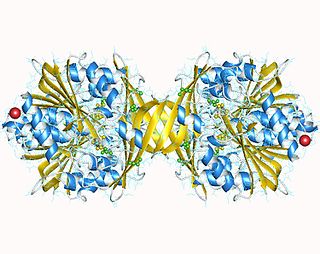| anthranilate N-methyltransferase | |||||||||
|---|---|---|---|---|---|---|---|---|---|
| Identifiers | |||||||||
| EC no. | 2.1.1.111 | ||||||||
| CAS no. | 123779-15-7 | ||||||||
| Databases | |||||||||
| IntEnz | IntEnz view | ||||||||
| BRENDA | BRENDA entry | ||||||||
| ExPASy | NiceZyme view | ||||||||
| KEGG | KEGG entry | ||||||||
| MetaCyc | metabolic pathway | ||||||||
| PRIAM | profile | ||||||||
| PDB structures | RCSB PDB PDBe PDBsum | ||||||||
| Gene Ontology | AmiGO / QuickGO | ||||||||
| |||||||||
In enzymology, an anthranilate N-methyltransferase (EC 2.1.1.111) is an enzyme that catalyzes the chemical reaction
- S-adenosyl-L-methionine + anthranilate S-adenosyl-L-homocysteine + N-methylanthranilate
Thus, the two substrates of this enzyme are S-adenosyl methionine and anthranilate, whereas its two products are S-adenosylhomocysteine and N-methylanthranilate.
This enzyme belongs to the family of transferases, specifically those transferring one-carbon group methyltransferases. The systematic name of this enzyme class is S-adenosyl-L-methionine:anthranilate N-methyltransferase. This enzyme is also called anthranilic acid N-methyltransferase. This enzyme participates in acridone alkaloid biosynthesis.


